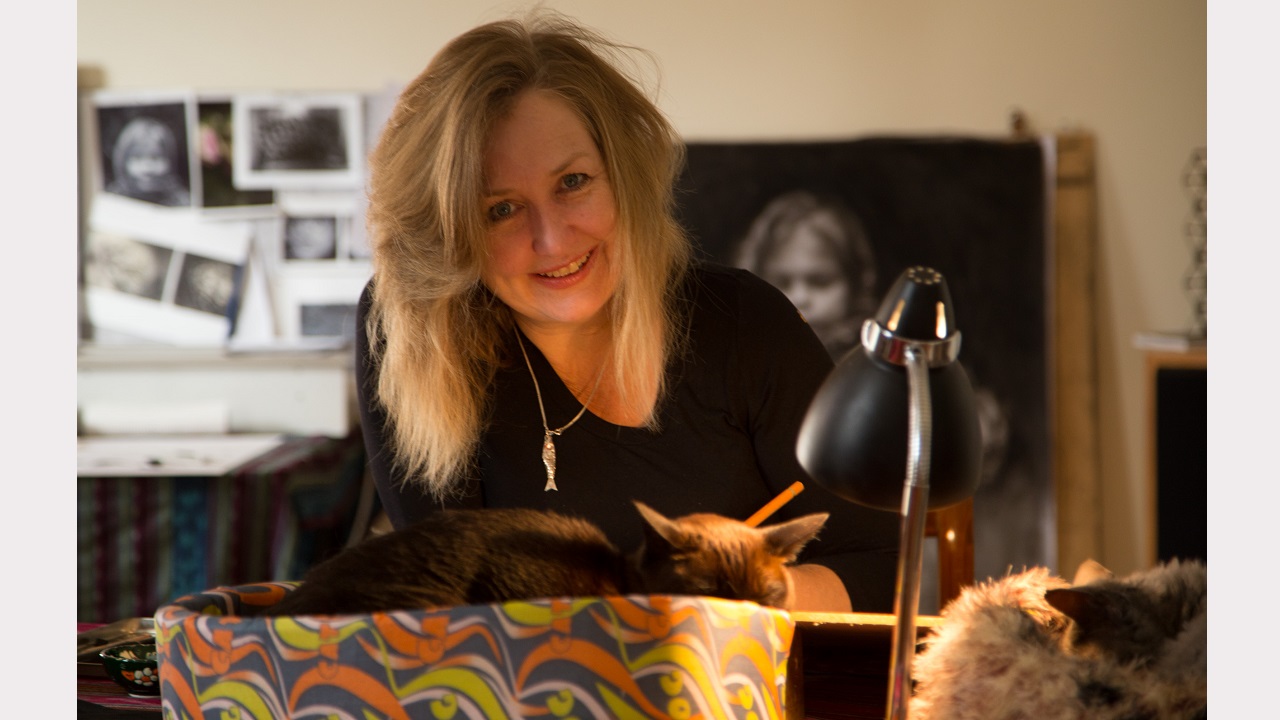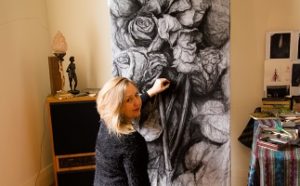Charcoal art works explore process of dying and impact on staff
Charcoal art works explore process of dying and impact on staff
by Heather Wiseman
Tuesday, July 18, 2017
As an artist, Margaret Ambridge offers exquisite insights into dying, human frailty, strength and love, all informed by her experiences working in palliative care. In September, her work will be exhibited at the Australian Palliative Care Conference in Adelaide.
Hospice-based physiotherapist, Margaret Ambridge, has taken to a bed sheet with charcoal. Sensibly, given her medium, the award-winning artist has chosen to wear black.
Margaret has hooked the sheet over a door and is building the greys up, layer by layer, smudging them, rubbing them away and then adding more. Meticulously she brings life to an exquisite bunch of roses on her large, symbolic canvas.
The flowers, like most of Margaret’s work, reflect what she has seen, heard and felt as she has shared intimate moments with people who are dying over the past 30 years. One patient, who Margaret says she will never forget, was surrounded by such a variety of flowers that her room looked like a florist shop. Under her bed Margaret found a bunch of roses that had been overlooked, missed out on a vase and started to dry out.
Margaret and the woman agreed that although the flowers had nearly died, they were still beautiful.
“I asked her if possibly I could take them home and draw them,” says Margaret.
“She said that would be a lovely idea and from that the exhibition sort of started.”
Margaret was saddened a couple of days later to visit the woman and find that she was dying.
“She had no [family] there, but she still had the flowers and I still had her flowers at home.”

Margaret believes that health professionals are deeply affected by working in palliative care. She is working on an exhibition for the Australian Palliative Care Conference in Adelaide in September which will explore the process of dying and the effect it has on staff.
“You have to be so professional all the time and not show any emotion. It is very difficult. And patients are looking for that one nurse or doctor who looks like they have connected with them and understand them; that they are a little bit special to them and they put that extra effort in. We are forever trying to get that balance. You have to remain professional in intensely emotional situations but obviously, you are affected by it because you are human.”
Margaret says she works in charcoal because it offers intense blacks, vibrant whites, and many shades of grey in between, “which is what our lives are full of and what palliative care shows me every day”.
“There is a whole history under the final draft that you see and there are whispers of that that come through in the greys which not everybody sees and some do.
"That allows everybody to bring themselves to the piece of artwork and I think that’s where charcoal stands out.”
Margaret is working on an ethereal palliative-care room for the exhibition with walls of silk that move freely in a circle of suspended images. Titled ‘Breakthrough’, the room will capture the range of emotions that Margaret imagines palliative care patients may experience when they look at flowers, including when they are delirious or experiencing breakthrough pain.
Another of her works – a series of small charcoal drawings – is inspired by the glimpses of life she has seen walking down a corridor, past open doors to patients’ rooms.
“Those things do affect me and I’ve been drawing my response to those; they’re glimpses of moments in time that we wouldn’t normally see,” says Margaret.
“Some are happy and some are not so happy, but that’s what it’s like when you walk down the corridor.”
One captures a small dog jumping excitedly around a dying man’s bed. Margaret says it was a lovely moment that “lifted his world”.
Another is of a woman whose husband was so unwell she could no longer interact with him. She sat at the end of his bed for hours, holding their dog as though it was a baby.
“There was something so very profoundly beautiful about it; that her comfort came from the dog,” says Margaret.
Margaret will also present a short film in which she interviews consultants, nurses and allied health staff about palliative care patients they will never forget. They talk about the impact those patients have had on them personally and professionally.
“The video is trying to start a conversation about working in a tense and stressful environment and how they cope and respond to that,” says Margaret.
“I’ve had an amazing variety of responses and it is very moving. It is profoundly beautiful and I feel it is a privilege to hear some of these stories.”
The Adelaide exhibition, titled ’til death, shares its name with an image Margaret created in order to encourage hospice facilities to provide dying patients with the opportunity to share a double bed. The image, which was part of Palliative Care Australia’s art competition last year, depicts a couple hugging close as they lay together side by side, highlighting the power of touch and its importance from birth through to death.
Margaret has been chosen as one of three judges for this year’s art competition, which has the theme Connection with Community. She says it’s an art competition that has potential to benefit all who enter.
“It’s not about winning, it’s about being part of it, and being comfortable with sharing something quite intimate with others in a public forum.
“Art is a very powerful form of expression for an individual and also a tool for healing or working through your own feelings. It is a conversation with self. There is a therapeutic value in sharing that with others. It gives others the opportunity to relate.”
Entries for the 2017 competition close on 31 July. For details, and to enter, click here.
The 2017 Australian Palliative Care Conference will be held in Adelaide from 6-8 September at the Adelaide Convention Centre. For details and to register, click here.
